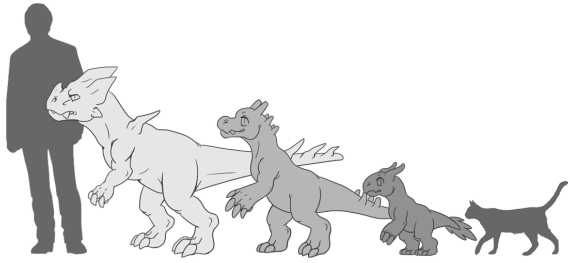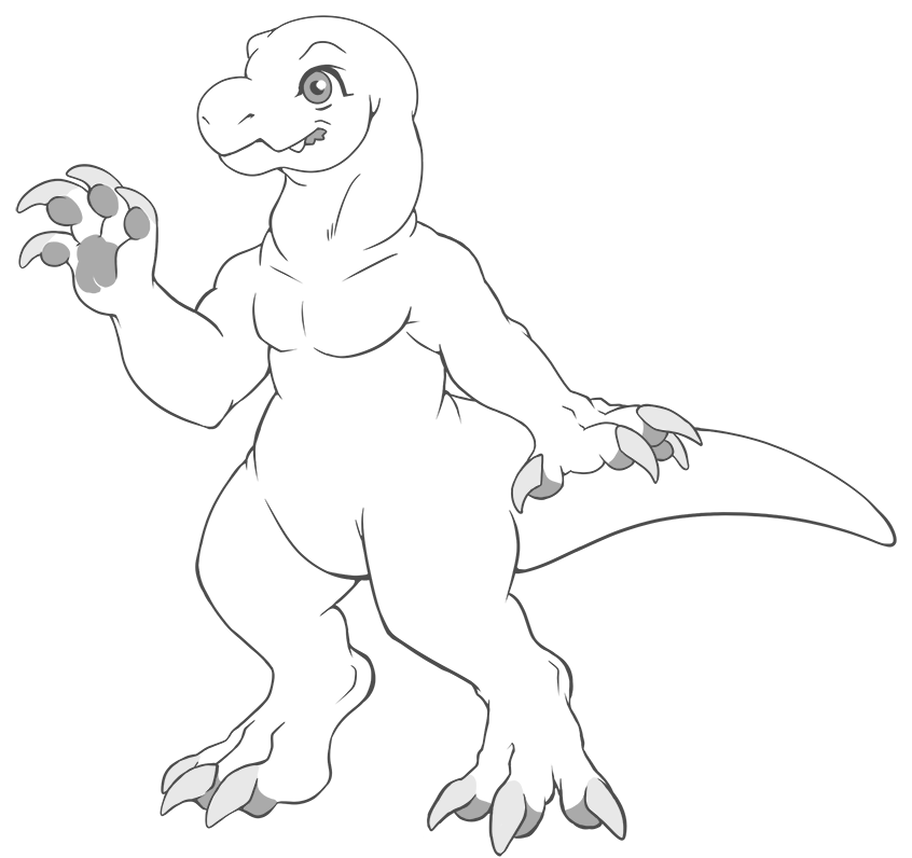Species
Snapadile
Visual Trait IndexSummary

Soul Essence Location: Eyes, Paw pads, mouth, blood, innards.
Bone/Teeth/Nail colour: White, or off-white.
Required Traits: Eyes, Tails, Horns, Texture, Teeth, Pawpads
Average Height:
Standard: 4ft - 5ft
Teacup (when upright): 2ft - 3ft
Prehistoric: 5ft - 8ft
Diet: Meat, Plants, Seafood, Minerals such as rocks or crystals. A Snapadile has a powerful bite that is able to penetrate rocks and bone with ease and grind them into dust.
Location: They can be located in most island regions, typically in warm tropical-forest climates and near coastal areas.
✦ General Info ✦
General Info

(Snap-ah-dile)
Snapadiles, aptly named for their habit of quickly snapping up food, are reptile-like kaiju creatures. They hold the distinction of being the first inhabitants discovered on the enigmatic and largely unexplored JuJu Islands.
The domesticated Snapadiles commonly encountered are a far cry from their wild "Prehistoric" cousins. These modified creatures have been carefully bred to integrate seamlessly into society, serving various roles as caregivers, assistants, protectors, and cherished companions.
A common sight in most major cities, Snapadiles can be found diligently accompanying their owners, faithfully fulfilling their designated duties. Extensive documentation and ownership certificates are in place for most domesticated Snapadiles, ensuring responsible pet ownership and preventing encounters with potentially dangerous wild Snapadiles that may roam less populated areas.
Legends whisper of a curious love affair between the Earth and Water gods, resulting in the creation of the Snapadiles. This divine union supposedly explains their remarkable amphibious nature, allowing them to navigate both water and land with effortless grace.
✦ Anatomy ✦
Anatomy

Snapadile boasts smooth, almost skin-like scales, lacking bumps or lumps. This unique feature gives them an appearance reminiscent of a combination of snake scales and leather. Their powerful jaws and teeth are built for a tough task - crushing rock and bones.
These creatures primarily walk upright. However, the Teacup breed is an exception, possessing the remarkable ability to walk on both two and four legs. Opposable thumbs on their three-fingered hands (one thumb per hand) grant them dexterity for picking up objects. Three toes grace each foot.
Snapadiles inner ears share similarities with reptiles. Complementing these are their squishy paw pads. Despite their softness, these pads are durable enough to handle most terrain. But here's the surprising part: they're also sensitive enough to feel tremors on the ground! An additional protective layer comes in the form of a third eyelid.
Large claws are a common feature, used for various tasks. However, the Prehistoric breed breaks the mold, favoring its formidable teeth over its hands for work. When it comes to soul color, it can manifest in various locations: the eyes, the paws, and even internally, within the blood, innards, and mouth.
✦ Head Shape ✦
Head Shapes

Snapadile heads exhibit a remarkable variety in shape and size. This variation often serves a specific purpose, such as appearing intimidating to predators or enhancing their ability to smell food from greater distances. These traits can be even more pronounced depending on the specific tasks a Snapadile performs within its community.
Some Snapadiles also possess fur on their heads, resembling hair. Interestingly, this "hair" can even be styled, allowing for a degree of individual expression.
✦ Behaviour ✦
Behaviour

Snapadiles are fairly sociable creatures, often seen huddling together in distinct groups that resemble small societies. Within these societies, each Snapadile plays a specific role, contributing to the well-being of the group. These roles can range from caring for young, elderly, or frail members to hunting and gathering necessities.
Leadership structures vary among Snapadile groups. While some have a single strong leader, others function with co-leaders. Additionally, Snapadiles exhibit a strong hoarding instinct, meticulously collecting and safeguarding items for the group's benefit. However, much like squirrels, they can sometimes misplace their hidden stashes.
Snapadiles possess a complex vocal repertoire that includes clicks, chirps, growls, and purrs. They can even comprehend simple words spoken by other species. Their sounds are highly nuanced, and like some animals, they use distinct vocalizations to communicate with each other. Body language also plays a crucial role in Snapadile communication, varying depending on the interaction. Facial expressions are equally significant, with tail twitching and snarling indicating annoyance, while smiling and clapping their hands suggest amusement.
✦ Life Cycle ✦
Life cycle


Birth:
A Snapadile's life begins within an egg. The egg's outer shell often displays markings or a blend of patterns inherited from both parents. Parents, and sometimes the entire group if the Snapadiles are social, fiercely guard these eggs. Interestingly, some speculate that the environment where the egg is laid can influence the offspring's elemental abilities.
A developing fetus and a newly hatched Snapadile are incredibly fragile. At this stage, they bear little resemblance to their parents. Their appearance is ultimately influenced by the type of food they consume after hatching, as well as their inherent genetic traits.
It takes a newborn Snapadile only a few hours to find its feet. Its initial instinct is to vocalize its need for food or attempt to scavenge for sustenance independently.
Death:
A healthy Snapadile can live for an average of 60 years or even longer.
Death typically occurs when a Snapadile loses its purpose in life and simply fades away, or succumbs to an injury too severe to heal. Their colors and patterns gradually degenerate over time, transforming into a dull, clay-like gray. They then slowly dissolve back into the earth, their bodies returning to the soil. A stone often remains as a memento, formed from their bones.
